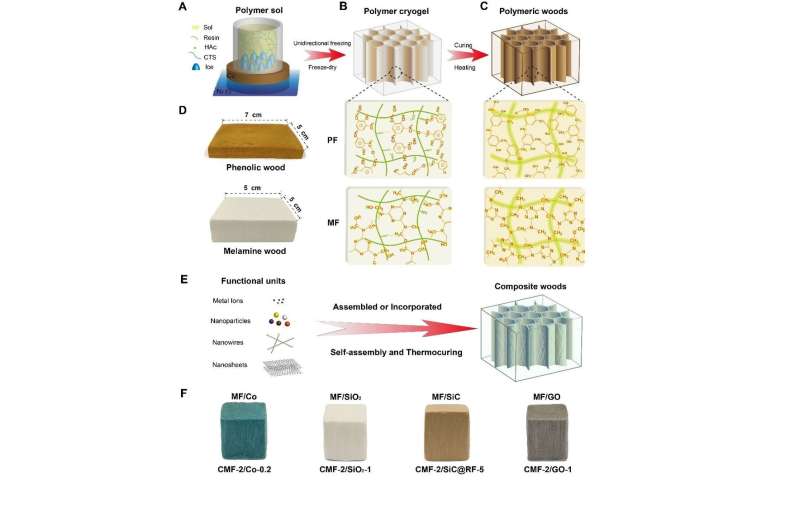Team develops a family of bioinspired artificial woods from traditional resins

Nature has provided the inspiration for the design and fabrication of high-performance biomimetic engineering materials. Wood, which has been used for thousands of years, has received considerable attention due to the low density and high strength. A unique anisotropic cellular structure endows wood with outstanding mechanical performance. In recent decades, researchers have developed monolithic materials with anisotropic cellular structures attempting to mimic wood. However, these reported artificial wood-like materials suffer from unsatisfactory mechanical properties. It is still a significant challenge to fabricate artificial wood-like materials with the lightweight and high-strength properties of real wood.
Recently, a research team led by Prof. YU Shuhong from the University of Science and Technology of China (USTC) have demonstrated a novel strategy for large-scale fabrication of a family of bioinspired polymeric woods with similar polyphenol matrix materials, wood-like cellular microstructures, produced via a process of self-assembly and thermocuring of traditional resins (phenolic resin and melamine resin). This work was reported in Science Advances in a paper titled "Bioinspired polymeric woods" on August 10th.
The liquid thermoset resins were first unidirectionally frozen to prepare a "green body" with the cellular structure, followed by the subsequent thermocuring. The resulting artificial wood bears a close resemblance to natural wood in the mesoscale cellular structures, and exhibits high controllability in the pore size and wall thickness. Benefiting from the starting aqueous solution, it also represents a green approach to preparing multifunctional artificial woods by compositing various nanomaterials such as cellulose nanofibers and graphene oxide.
The polymeric and composite woods manifest lightweight and high-strength properties, with mechanical strength comparable to that of natural wood. In contrast with natural wood, the artificial wood exhibits better corrosion resistance to water and acid with no decrease in mechanical properties, as well as much better thermal insulation and fire retardancy. The artificial polymeric woods even stand out from other engineering materials such as cellular ceramic materials and aerogels in terms of specific strength and thermal insulation properties. As a kind of biomimetic engineering material, this new family of bioinspired polymeric woods could replace natural wood for use in harsh environments.
This novel strategy provides a new and powerful means to fabricate and engineer a wide range of high-performance biomimetic engineering composite materials with desirable multifunctionality and advantages over traditional counterparts. They will likely have broad applications in many technical fields.
More information: Zhi-Long Yu et al. Bioinspired polymeric woods, Science Advances (2018). DOI: 10.1126/sciadv.aat7223
Journal information: Science Advances
Provided by University of Science and Technology of China




















